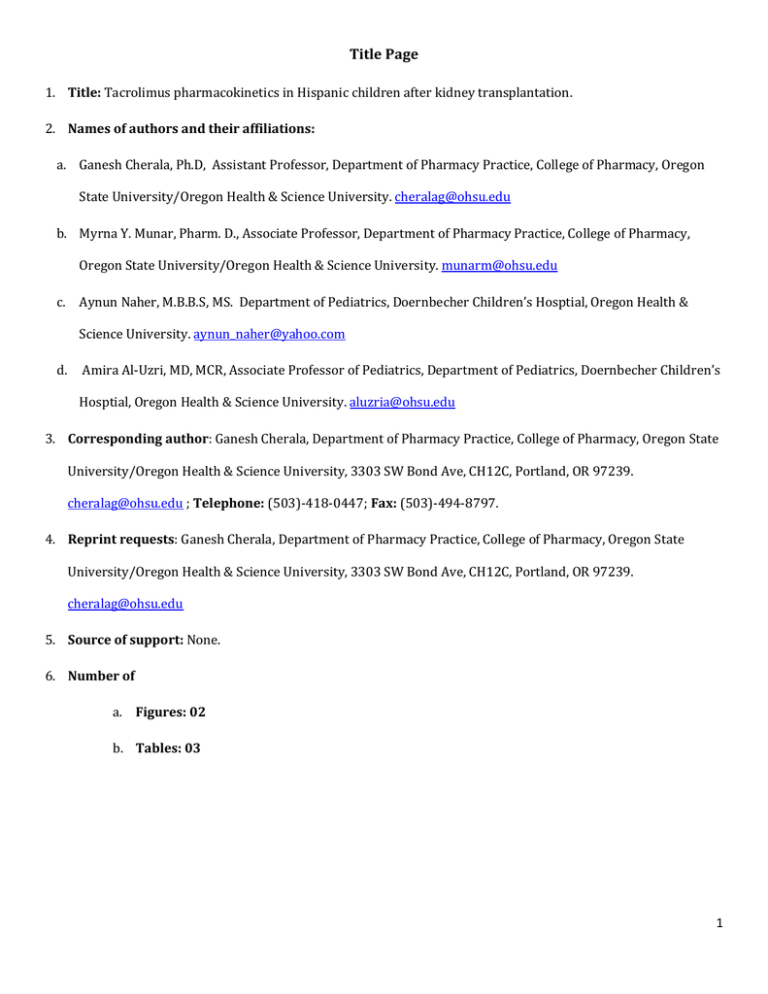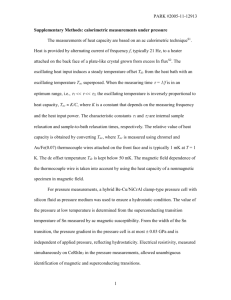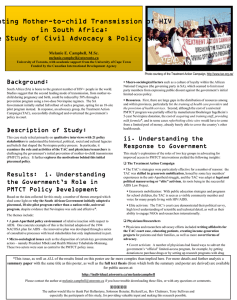Title Page
advertisement

Title Page 1. Title: Tacrolimus pharmacokinetics in Hispanic children after kidney transplantation. 2. Names of authors and their affiliations: a. Ganesh Cherala, Ph.D, Assistant Professor, Department of Pharmacy Practice, College of Pharmacy, Oregon State University/Oregon Health & Science University. cheralag@ohsu.edu b. Myrna Y. Munar, Pharm. D., Associate Professor, Department of Pharmacy Practice, College of Pharmacy, Oregon State University/Oregon Health & Science University. munarm@ohsu.edu c. Aynun Naher, M.B.B.S, MS. Department of Pediatrics, Doernbecher Children’s Hosptial, Oregon Health & Science University. aynun_naher@yahoo.com d. Amira Al-Uzri, MD, MCR, Associate Professor of Pediatrics, Department of Pediatrics, Doernbecher Children’s Hosptial, Oregon Health & Science University. aluzria@ohsu.edu 3. Corresponding author: Ganesh Cherala, Department of Pharmacy Practice, College of Pharmacy, Oregon State University/Oregon Health & Science University, 3303 SW Bond Ave, CH12C, Portland, OR 97239. cheralag@ohsu.edu ; Telephone: (503)-418-0447; Fax: (503)-494-8797. 4. Reprint requests: Ganesh Cherala, Department of Pharmacy Practice, College of Pharmacy, Oregon State University/Oregon Health & Science University, 3303 SW Bond Ave, CH12C, Portland, OR 97239. cheralag@ohsu.edu 5. Source of support: None. 6. Number of a. Figures: 02 b. Tables: 03 1 Introduction: The calcineurin inhibitor, tacrolimus (TAC), is widely used as the main immunosuppression medication in pediatric kidney transplantation1. It holds a narrow therapeutic index and displays wide interpatient variability in its pharmacokinetics. Oral bioavailability and metabolism of TAC are dependent on efflux pumps found in enterocytes in the gastrointestinal tract and cytochrome P-450 (CYP) isoenzymes located both in the gastrointestinal tract and in the liver. Hepatic metabolism is the principal route of TAC drug elimination. The bioavailability and metabolism of TAC vary among individuals based on variation in gene expression of intestinal p-glycoprotein, CYP3A4 and CYP3A5, age, ethnicity, race and concomitant medication intake. Studies in adult kidney transplant recipients show different pharmacokinetic (PK) profiles in Caucasians compared to African Americans and Asians2, 3. However, published data for TAC PK in Hispanics is scant particularly in children. Over the years we have observed a selective group of our Hispanic children after kidney transplantation requiring a higher mg/kg/dose of TAC or more frequent dosing (every 8 hours) to achieve our target therapeutic trough levels of 5-8 ng/ml. Abbreviated TAC PK studies were done to determine optimal TAC dosing and frequency of administration and to rule out non adherence as a cause for the low TAC trough levels. We report in this retrospective analysis, our findings on TAC PK differences observed in the Hispanic vs. Non Hispanic patients in our pediatric transplant recipients. Methods: We conducted a retrospective chart review for all pediatric patients transplanted between 2001 and 2010 in our institution. The chart review was approved by the Institutional Review Board at our center. Twenty three TAC PK studies were performed as part of the clinical care in 15 pediatric kidney transplant recipients during that period. All PK studies were obtained in the outpatient clinic to assist in the clinical management of patients who demonstrated low 12 hour trough TAC levels over time. Five patients were eventually switched to an 8 hour schedule for TAC dosing. Based on their ethnicity we divided our patients into Hispanic and Non-Hispanic groups. All patients were on a steady state of TAC dose prior to performing the PK study. Patients were instructed to take their TAC dose at the usual schedule the night prior to the PK study. Those who were on 12 hour dosing were instructed to take their TAC dose at 8 PM the night before the study and those who were on 8 hour dosing were to take their dose at midnight. An abbreviated TAC PK study was performed using serial blood samples obtained at 0 2 hour (prior to the AM dose) , then at 1, 2, 4, and 6 hours following the 8 AM oral TAC dose. Blood TAC levels were analyzed by a radioimmunoassay. Blood TAC concentration-time data were analyzed by noncompartmental methods (WinNonLin 5.2, Pharsight Inc., Mountain View, CA). Area under the drug concentration-time curve during the dosing interval (AUC0-τau) was determined using the linear trapezoidal rule. Terminal area was the quotient of the last concentration divided by the terminal elimination rate constant (z). This constant was determined from regression analysis of concentration-time points in the terminal elimination phase. AUC0-τau was added to the terminal area to obtain total AUC0-∞. Maximum drug concentration (Cmax) and time to reach the maximum drug concentration (Tmax) were the observed values. Terminal elimination half-life (t1/2) was calculated as 0.693/z, oral clearance (CL/F) was calculated as dose/AUC0-, and volume of distribution by area (VD) was calculated as CL/F/z. Statistical Analysis: Data between Hispanic vs non-Hispanic patients were compared using the Student’s ttest. Pearson-Product Correlations (R) were used to determine the relationship between demographic and laboratory data and tacrolimus PK parameters. Statistical significance was defined at P < 0.05 (SigmaPlot 11, Systat Software Inc., San Jose, CA). Results: Twenty three TAC PK studies were performed in 15 patients during the study period. Patient demographics and characteristics are depicted in table 1. Five patients were on an eight hour TAC dosing (two were Hispanic, 40%), while the remaining 10 patients (three were Hispanic, 30%) were on a 12 hour TAC dosing regimen. One patient was excluded from the PK analysis because blood TAC levels remained elevated during the dosing interval (due to an error in performing the PK study), and hence PK parameters could not be determined accurately. The Tac PK profiles for Hispanic and non-Hispanic pediatric subjects are presented in figure 1. The detailed TAC PK parameters in the remaining 14 patients are presented in table 2. When normalized to the administered dose, both the average Cmax (4.94 ±2.42 vs 6.39 ± 3.99 ng/mL/mg) and AUC0-∞ (32.54 ± 11.50 vs 56.56 ± 32.17 ng/mL×hr/mg) were lower in Hispanic compared to non-Hispanic patients (figure 1; table 2). VD was higher in Hispanic vs non-Hispanic patients (193464 ± 88665 vs 169852 ± 111904 mL respectively). Oral TAC clearance was faster in Hispanic when compared to non-Hispanic patients (34622 ±10851 vs 25135 ±14658 mL/hr respectively), resulting in a shorter half-life (3.9 ±1.5 vs 7.9 ±12.7 hrs). 3 In Hispanic patients, the measure of drug exposure-AUC increased linearly with body weight (table 3). On the other hand, as body weight increased, TAC clearance decreased. Similarly, as age increased, a decrease in TAC volume of distribution was observed. A strong correlation was found between schwartz eGFR and TAC half-life in Hispanic patients. Increased eGFR was also associated with reductions in TAC volume of distribution in nonHispanic patients, however failed to reach statistical significance (P = 0.059). Except for the above weak correlation, no other correlations were observed in non-Hispanic patients. The differences in the trough levels of TAC between Hispanic and non-Hispanic children are presented in Figure.2. Though there were only 5 Hispanic and 10 non-Hispanic subjects in this study, four patients had multiple PK studies and hence multiple trough levels were collected from them. Large inter individual variability is observed in both patient groups the Hispnanic vs. non-Hispanics. Discussion: The long term graft outcome in Hispanic adults with kidney transplantation is surprisingly comparable or superior to Caucasian and African American recipients despite many odds such as the prevalence of diabetes and other socioeconomic factors4. The Hispanic Paradox is described for such a phenomenon and can be explained by the younger age group of the Hispanic recipients, the prevalence of living donation, the stronger family support system and other factors4. However, these data are inconclusive for the Hispanic pediatric recipients with few reports suggesting similar trends as the adults 5. Multiple factors may play a role in establishing differences in long term graft outcome among children with different ethnic backgrounds, one of which is the biological differences in drug metabolism and pharmacokinetics. Our limited retrospective analysis of TAC PK profiles in Hispanic vs. non-Hispanic children with kidney transplants suggests that important differences may exist in various PK parameters. However, these differences were not statistically significant as expected by the small sample size. Furthermore, the ability to show significant differences between the 2 groups was compromised by the sizable variability in PK data in the non-Hispanic group that included patients with Caucasian and African American races, thus accentuating the individual variability in TAC PK profiles in this group. Despite the large inter individual variability (figure 2), the means of trough levels of TAC at time 0 (just before the 8 AM morning TAC dose, appear to be similar between Hispanic and non-Hispanic 4 children in figure 1. However, the similar trough levels could be misleading as some patients were on 8 hour TAC dosing while others were on 12 hour dosing. We found that the measure of drug exposure per individual patient determined by the AUC, upon normalization to the administered dose (mg/kg or per SA), tends to be smaller in Hispanic patients. This would suggest that Hispanic patients require a higher dose than the non-Hispanic patients to achieve the desired drug exposure. Or alternatively, a more frequent dosing of the calculated normalized dose (mg/kg or BSA) may be warranted in Hispanic patients. The shorter half life of TAC in Hispanics further supports the idea of using either a higher dose of TAC every 12 hours or more frequent dosing, i.e., every 8 hours. Half life is another measure of how rapidly drugs are cleared from the body which is determined by the status of relevant drug metabolizing enzymes and transporters. As shown in table 2, Hispanic patients exhibited a faster TAC clearance compared to the non-Hispanics. This could be due to the higher expression of drug metabolizing enzymes and/or transporters leading to faster clearance of TAC. Cytochrome P4503A is the principal drug metabolizing enzyme for TAC. The reported ethnic variability in hepatic CYP3A activity or expression is inconsistent among publications and is poorly characterized in the literature. Mancinelli et al found no differences in intravenous TAC PK profiles in Caucasian, African American and Hispanic healthy adult volunteers 3. However, lower intestinal bioavailability was clearly observed in African American subjects compared to the Caucasian and the Hispanic groups when given orally. This observation was attributed to ethnically associated differences in intestinal CYP3A or P-glycoprotein activity or both rather than to hepatic CYP3A activity 3. However, no data has been reported thus far in pediatric patients. Our study with limited sample size suggests potential differences in either CYP3A or Pgp or both between Hispanic and non-Hispanic children. This preliminary observation needs to be followed up with a larger study. The significant correlation of body weight to TAC clearance in Hispanic children is an interesting observation while such correlation is absent in non-Hispanic children. This finding is relevant especially given the higher rate of obesity in hispanic children compared to non-hispanic children. Obesity is considered to be a proinflammatory condition with elevated levels of plasma cytokines 6 which are known modulators of the expression of various Cytochrome P450 enzymes including Cytochrome P4503A in adults 7-9. Our study extends this observation to children; though it is not clear to the authors why this observation is found only in Hispanic 5 children. Similar to body weight correlation to TAC clearance, the strong correlation between age and volume of distribution of TAC is observed only in Hispanic children. Aging related changes in drug pharmacokinetics, including distribution is well studied in adults and children 10. Age associated changes in body mass and protein binding is shown to decrease volume of distribution for water-soluble drugs, and an increase for lipophilic drugs. TAC is a poorly water-soluble drug11, and therefore the authors expected an increase in TAC volume of distribution. On the contrary, we have observed a lack of correlation in non-Hispanic children, and more surprisingly a decrease in non-Hispanic children. TAC is very highly bound to erythrocytes and plasma proteins mainly lipoproteins 12. Any increases in the plasma concentrations of lipoproteins could increase the amount of drug bound to plasma proteins leading to a decrease in volume of distribution. Plasma concentrations of small dense LDL and lipoprotein-a are higher in adult Hispanics compared to non-Hispanic adults13. Though, similar comparisons are unavailable in children, extrapolating adult comparisons to children could potentially explain our observation. Our hypothesis is based on a small sample size and begs confirmation using a large sample study. The limitation of this small retrospective analysis is that it included only those patients with problems achieving adequate target TAC trough levels. Selection bias may have played a role in our final results however the propensity of Hispanics in this group of patients lead us to hypothesize that there might be true differences based on ethnic background. In addition, due to the sample size, this study has not considered other independent variables such as age of pediatric patient which was shown to be inversely correlated to TAC dose 14. Given these limitations, our study stresses the need for a large prospective study in pediatric population to understand ethnic differences in TAC pharmacokinetics. In summary, we found that a number of our Hispanic children post kidney transplantation exhibited lower AUC for a TAC dose when adjusted for weight or surface area, and larger volume of distribution, thus requiring higher or more frequent dosing of TAC. Clinicians may elect to perform TAC PK studies in Hispanic children who fail to achieve target TAC trough levels post kidney transplantation. REFERENCES: 1. Gummert JF, Ikonen T, Morris RE. Newer immunosuppressive drugs: a review. J Am Soc Nephrol 1999;10:1366. 2. Dirks NL, Huth B, Yates CR, Meibohm B. Pharmacokinetics of immunosuppressants: a perspective on ethnic differences. Int J Clin Pharmacol Ther 2004;42:701. 3. Mancinelli LM, Frassetto L, Floren LC, et al. The pharmacokinetics and metabolic disposition of tacrolimus: a comparison across ethnic groups. Clin Pharmacol Ther 2001;69:24. 6 4. Gordon EJ, Caicedo JC. Ethnic advantages in kidney transplant outcomes: the Hispanic Paradox at work? Nephrol Dial Transplant 2009;24:1103. 5. Jarzembowski T, John E, Panaro F, et al. Impact of non-compliance on outcome after pediatric kidney transplantation: an analysis in racial subgroups. Pediatr Transplant 2004;8:367. 6. Guo C, Ricchiuti V, Lian BQ, et al. Mineralocorticoid receptor blockade reverses obesity-related changes in expression of adiponectin, peroxisome proliferator-activated receptor-gamma, and proinflammatory adipokines. Circulation 2008;117:2253. 7. Blouin RA, Warren GW. Pharmacokinetic considerations in obesity. J Pharm Sci 1999;88:1. 8. Hunt CM, Watkins PB, Saenger P, et al. Heterogeneity of CYP3A isoforms metabolizing erythromycin and cortisol. Clin Pharmacol Ther 1992;51:18. 9. Hunt CM, Westerkam WR, Stave GM, Wilson JA. Hepatic cytochrome P-4503A (CYP3A) activity in the elderly. Mech Ageing Dev 1992;64:189. 10. Birnbaum LS. Pharmacokinetic basis of age-related changes in sensitivity to toxicants. Annu Rev Pharmacol Toxicol 1991;31:101. 11. Tamura S, Ohike A, Ibuki R, Amidon GL, Yamashita S. Tacrolimus is a class II low-solubility high-permeability drug: the effect of P-glycoprotein efflux on regional permeability of tacrolimus in rats. J Pharm Sci 2002;91:719. 12. Zahir H, Nand RA, Brown KF, Tattam BN, McLachlan AJ. Validation of methods to study the distribution and protein binding of tacrolimus in human blood. J Pharmacol Toxicol Methods 2001;46:27. 13. Watson KE. Plasma lipoprotein concentrations in ethnic populations. Curr Cardiol Rep 2003;5:483. 14. Kim JS, Aviles DH, Silverstein DM, Leblanc PL, Matti Vehaskari V. Effect of age, ethnicity, and glucocorticoid use on tacrolimus pharmacokinetics in pediatric renal transplant patients. Pediatr Transplant 2005;9:162. 7





